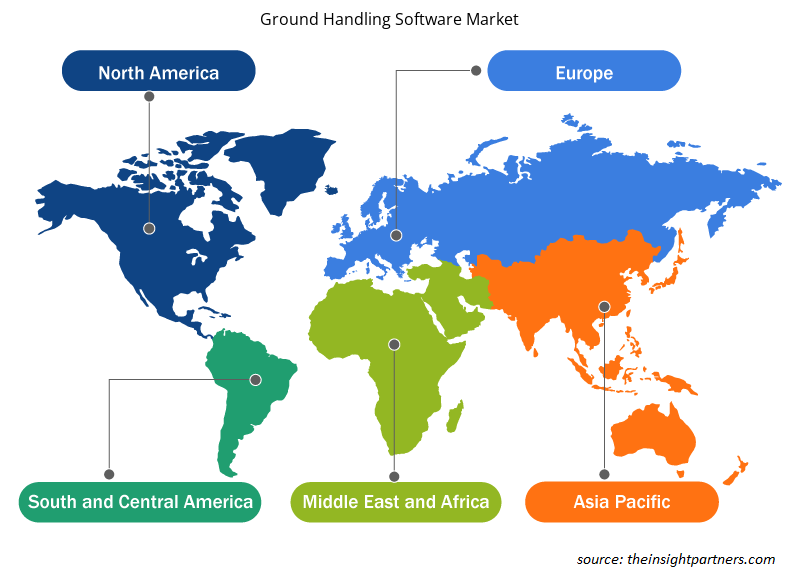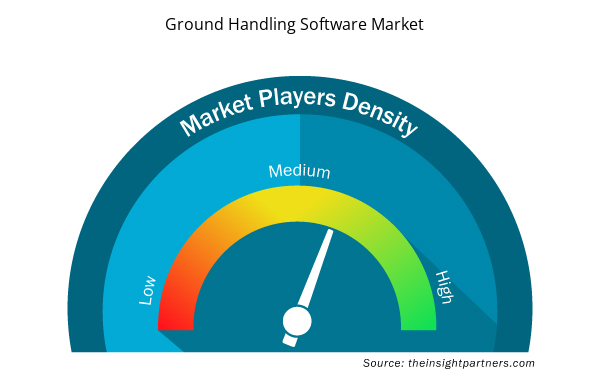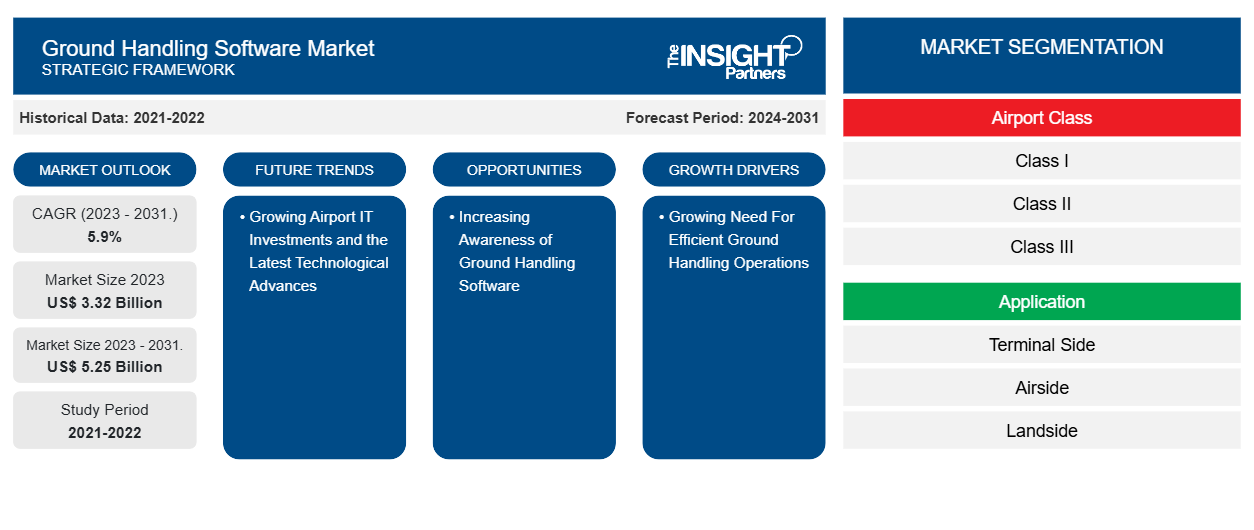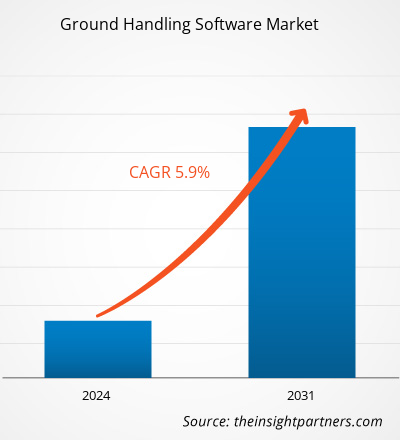Si prevede che la dimensione del mercato del software di assistenza a terra raggiungerà i 5,25 miliardi di dollari entro il 2031, rispetto ai 3,32 miliardi di dollari del 2023. Si prevede che il mercato registrerà un CAGR del 5,9% nel periodo 2023-2031. I crescenti investimenti IT aeroportuali e gli ultimi progressi tecnologici rimarranno probabilmente una tendenza chiave nel mercato.
Analisi di mercato del software di assistenza a terra
La domanda di software per la gestione a terra è in continuo aumento a causa delle innovazioni tecnologiche e del desiderio di operazioni aeroportuali efficienti. L'implementazione di sistemi digitali che includono automazione, analisi dei dati e cloud computing per ottimizzare le procedure di gestione a terra è in aumento. Inoltre, la spinta verso l'iniezione di nuove tecnologie e sistemi operativi nel settore è sollecitata da un ambiente normativo di sicurezza rigoroso e da un'interazione self-service dei passeggeri accresciuta.
Panoramica del mercato del software di assistenza a terra
Il software di ground handling è un sistema che consente di fornire a terra tutti i servizi svolti sull'aereo in modo rapido e nel miglior modo possibile. Includono cose come rifornimento, catering, movimentazione bagagli e manutenzione dell'aeromobile. Il software di ground handling è la misura definitiva che ha fornito ai fornitori di servizi come carburante extra e velocità di crociera extra, che sono cruciali per ridurre i tempi di turnaround dell'aeromobile e quindi aumentare i ricavi.
Personalizza questo report in base alle tue esigenze
Riceverai la personalizzazione gratuita di qualsiasi report, comprese parti di questo report, o analisi a livello nazionale, pacchetto dati Excel, oltre a usufruire di grandi offerte e sconti per start-up e università
- Scopri le principali tendenze di mercato in questo rapporto.Questo campione GRATUITO includerà analisi di dati che spaziano dalle tendenze di mercato alle stime e alle previsioni.
Driver e opportunità del mercato del software di assistenza a terra
Crescente necessità di operazioni di assistenza a terra efficienti
La crescente domanda di una gestione efficiente delle operazioni di terra negli aeroporti è guidata dalla necessità di ridurre i costi operativi e migliorare la soddisfazione del cliente. Con gli aeroporti che stanno vivendo un allarmante aumento della congestione, le compagnie aeree stanno attualmente cercando modi per ridurre i tempi di turnaround, migliorare l'accuratezza delle operazioni di movimentazione e ridurre i ritardi. Il software di movimentazione a terra è la soluzione che consente alle compagnie aeree di gestire le attività di terra con facilità, riducendo così i costi operativi e migliorando l'esperienza del cliente. La tecnologia semplifica le procedure coinvolte nella movimentazione e aiuta una compagnia aerea a prepararsi in anticipo per le avversità del crescente traffico aereo in un ambiente operativo altamente efficace e orientato al cliente.
Aumentare la consapevolezza del software di assistenza a terra
La consapevolezza in rapida crescita dei vantaggi che il software di assistenza a terra può portare all'adozione dell'automazione e della tecnologia nelle operazioni di assistenza a terra continua ad aumentare. Comprendendo la competitività di un settore, le compagnie aeree cercano modi per migliorare la produttività operativa riducendo al contempo i costi, essendo sensibili al prezzo. Il software di assistenza a terra fornisce alle compagnie aeree i mezzi per automatizzare la maggior parte delle loro operazioni di assistenza a terra; questo, quindi, riduce i costi generali e migliora l'efficienza operativa. La crescente consapevolezza di questi vantaggi alimenta effettivamente il tasso di adozione del software di assistenza a terra negli aeroporti.
Analisi della segmentazione del rapporto di mercato del software di assistenza a terra
I segmenti chiave che hanno contribuito alla derivazione dell'analisi di mercato del software di assistenza a terra sono la classe di aeroporto, l'applicazione e il tipo di software.
- In base alla classe aeroportuale, il mercato è segmentato in Classe I, Classe II, Classe III e Classe IV. Il segmento Classe I ha detenuto una quota di mercato significativa nel 2023.
- In termini di applicazione, il mercato è segmentato in terminal side, airside e landside. Il segmento terminal side ha detenuto una quota di mercato significativa nel 2023.airside, and landside. The terminal side segment held a significant market share in 2023.
- In base al tipo di software, il mercato è segmentato in controllo di imbarco e partenza passeggeri, gestione bagagli, controllo automatizzato di merci e carichi, tracciamento GSE (telemetria) e gestione rampa. Il segmento di gestione bagagli ha detenuto una quota di mercato significativa nel 2023.GSE tracking (telemetry), and ramp management. The baggage management segment held a significant market share in 2023.
Analisi della quota di mercato del software di assistenza a terra per area geografica
L'ambito geografico del rapporto sul mercato del software per l'assistenza a terra è suddiviso principalmente in cinque regioni: Nord America, Asia Pacifico, Europa, Medio Oriente e Africa, e Sud e Centro America.
Il mercato del software di assistenza a terra del Nord America sta crescendo rapidamente a causa della crescente domanda di soluzioni di assistenza a terra efficienti e convenienti da parte di varie compagnie aeree e aeroporti. Questa regione ospita la maggior parte delle più grandi compagnie aeree e aeroporti del mondo, che stanno investendo molto in software di assistenza a terra per apportare miglioramenti nell'efficienza operativa e nella riduzione dei costi. I fornitori di software di assistenza a terra nella regione sono aumentati, motivando così la concorrenza e l'innovazione. Nel complesso, la crescita del mercato del software di assistenza a terra del Nord America è forte, sostenuta dalla crescente domanda da parte di compagnie aeree e aeroporti di soluzioni di assistenza a terra efficienti e convenienti, dall'aumento dei fornitori di software di assistenza a terra e dall'adozione di soluzioni basate su cloud.
Approfondimenti regionali sul mercato del software di assistenza a terra
Le tendenze regionali e i fattori che influenzano il mercato del software di assistenza a terra durante il periodo di previsione sono stati ampiamente spiegati dagli analisti di Insight Partners. Questa sezione discute anche i segmenti e la geografia del mercato del software di assistenza a terra in Nord America, Europa, Asia Pacifico, Medio Oriente e Africa e America meridionale e centrale.

- Ottieni i dati specifici regionali per il mercato del software di assistenza a terra
Ambito del rapporto di mercato sul software di assistenza a terra
| Attributo del report | Dettagli |
|---|---|
| Dimensioni del mercato nel 2023 | 3,32 miliardi di dollari USA |
| Dimensioni del mercato entro il 2031 | 5,25 miliardi di dollari USA |
| CAGR globale (2023 - 2031.) | 5,9% |
| Dati storici | 2021-2022 |
| Periodo di previsione | 2024-2031 |
| Segmenti coperti | Per classe di aeroporto
|
| Regioni e Paesi coperti | America del Nord
|
| Leader di mercato e profili aziendali chiave |
|
Densità dei player del mercato del software di assistenza a terra: comprendere il suo impatto sulle dinamiche aziendali
Il mercato del software di Ground Handling sta crescendo rapidamente, spinto dalla crescente domanda degli utenti finali dovuta a fattori quali l'evoluzione delle preferenze dei consumatori, i progressi tecnologici e una maggiore consapevolezza dei vantaggi del prodotto. Con l'aumento della domanda, le aziende stanno ampliando le loro offerte, innovando per soddisfare le esigenze dei consumatori e capitalizzando sulle tendenze emergenti, il che alimenta ulteriormente la crescita del mercato.
La densità degli operatori di mercato si riferisce alla distribuzione di aziende o società che operano in un particolare mercato o settore. Indica quanti concorrenti (operatori di mercato) sono presenti in un dato spazio di mercato in relazione alle sue dimensioni o al valore di mercato totale.
Le principali aziende che operano nel mercato del software per l'assistenza a terra sono:
- Società a responsabilità limitata
- Avtura limitata
- Damarel Systems International Ltd.
- INFORMA GmbH
- Soluzioni per l'aviazione quantistica
- Quonesto
Disclaimer : le aziende elencate sopra non sono classificate secondo un ordine particolare.

- Ottieni una panoramica dei principali attori del mercato del software di assistenza a terra
Notizie di mercato e sviluppi recenti del software di assistenza a terra
Il mercato del software di ground handling viene valutato raccogliendo dati qualitativi e quantitativi dopo la ricerca primaria e secondaria, che include importanti pubblicazioni aziendali, dati associativi e database. Di seguito sono elencati alcuni degli sviluppi nel mercato del software di ground handling:
- Menzies Aviation, il principale partner di servizi per aeroporti e compagnie aeree di tutto il mondo, insieme alla società leader di servizi tecnologici e consulenza Wipro, ha annunciato il lancio con successo del suo nuovo sistema di gestione del carico Menzies Aviation Cargo Handling (MACH).
(Fonte: Menzies Aviation Limited, sito Web aziendale, dicembre 2023)
Copertura e risultati del rapporto di mercato del software di assistenza a terra
Il rapporto "Dimensioni e previsioni del mercato del software di assistenza a terra (2021-2031)" fornisce un'analisi dettagliata del mercato che copre le seguenti aree:
- Dimensioni e previsioni del mercato del software di assistenza a terra a livello globale, regionale e nazionale per tutti i segmenti di mercato chiave coperti dall'ambito
- Tendenze del mercato del software di assistenza a terra e dinamiche di mercato come conducenti, vincoli e opportunità chiave
- Analisi dettagliata delle cinque forze PEST/Porter e SWOT
- Analisi di mercato del software di assistenza a terra che copre le principali tendenze del mercato, il quadro globale e regionale, i principali attori, le normative e i recenti sviluppi del mercato
- Analisi del panorama industriale e della concorrenza che copre la concentrazione del mercato, l'analisi della mappa di calore, i principali attori e gli sviluppi recenti per il mercato del software di assistenza a terra
- Profili aziendali dettagliati
- Analisi storica (2 anni), anno base, previsione (7 anni) con CAGR
- Analisi PEST e SWOT
- Valore/volume delle dimensioni del mercato - Globale, regionale, nazionale
- Industria e panorama competitivo
- Set di dati Excel


- Point of Care Diagnostics Market
- Small Satellite Market
- Passport Reader Market
- Hot Melt Adhesives Market
- Intradermal Injection Market
- Artificial Intelligence in Healthcare Diagnosis Market
- Terahertz Technology Market
- Military Rubber Tracks Market
- Molecular Diagnostics Market
- Electronic Data Interchange Market

Report Coverage
Revenue forecast, Company Analysis, Industry landscape, Growth factors, and Trends

Segment Covered
This text is related
to segments covered.

Regional Scope
North America, Europe, Asia Pacific, Middle East & Africa, South & Central America

Country Scope
This text is related
to country scope.
Domande frequenti
The market is projected to record a CAGR of 5.9% during 2023–2031.
The market is expected to reach a value of US$ 5.25 billion by 2031.
Arepo Solutions Ltd., Avtura Limited, Damarel Systems International Ltd., INFORM GmbH, Quantum Aviation Solutions, Quonext, 1RESA Airport Data Systems, SITA, TOPSYSTEM SYSTEMHAUS GMBH, and Wiseleap are key players in the market.
Growing airport IT investments and the latest technological advances a key trends in the market.
The growing need for efficient ground handling operations is driving the market.
Trends and growth analysis reports related to Technology, Media and Telecommunications : READ MORE..
The Insight Partners performs research in 4 major stages: Data Collection & Secondary Research, Primary Research, Data Analysis and Data Triangulation & Final Review.
- Data Collection and Secondary Research:
As a market research and consulting firm operating from a decade, we have published and advised several client across the globe. First step for any study will start with an assessment of currently available data and insights from existing reports. Further, historical and current market information is collected from Investor Presentations, Annual Reports, SEC Filings, etc., and other information related to company’s performance and market positioning are gathered from Paid Databases (Factiva, Hoovers, and Reuters) and various other publications available in public domain.
Several associations trade associates, technical forums, institutes, societies and organization are accessed to gain technical as well as market related insights through their publications such as research papers, blogs and press releases related to the studies are referred to get cues about the market. Further, white papers, journals, magazines, and other news articles published in last 3 years are scrutinized and analyzed to understand the current market trends.
- Primary Research:
The primarily interview analysis comprise of data obtained from industry participants interview and answers to survey questions gathered by in-house primary team.
For primary research, interviews are conducted with industry experts/CEOs/Marketing Managers/VPs/Subject Matter Experts from both demand and supply side to get a 360-degree view of the market. The primary team conducts several interviews based on the complexity of the markets to understand the various market trends and dynamics which makes research more credible and precise.
A typical research interview fulfils the following functions:
- Provides first-hand information on the market size, market trends, growth trends, competitive landscape, and outlook
- Validates and strengthens in-house secondary research findings
- Develops the analysis team’s expertise and market understanding
Primary research involves email interactions and telephone interviews for each market, category, segment, and sub-segment across geographies. The participants who typically take part in such a process include, but are not limited to:
- Industry participants: VPs, business development managers, market intelligence managers and national sales managers
- Outside experts: Valuation experts, research analysts and key opinion leaders specializing in the electronics and semiconductor industry.
Below is the breakup of our primary respondents by company, designation, and region:

Once we receive the confirmation from primary research sources or primary respondents, we finalize the base year market estimation and forecast the data as per the macroeconomic and microeconomic factors assessed during data collection.
- Data Analysis:
Once data is validated through both secondary as well as primary respondents, we finalize the market estimations by hypothesis formulation and factor analysis at regional and country level.
- Macro-Economic Factor Analysis:
We analyse macroeconomic indicators such the gross domestic product (GDP), increase in the demand for goods and services across industries, technological advancement, regional economic growth, governmental policies, the influence of COVID-19, PEST analysis, and other aspects. This analysis aids in setting benchmarks for various nations/regions and approximating market splits. Additionally, the general trend of the aforementioned components aid in determining the market's development possibilities.
- Country Level Data:
Various factors that are especially aligned to the country are taken into account to determine the market size for a certain area and country, including the presence of vendors, such as headquarters and offices, the country's GDP, demand patterns, and industry growth. To comprehend the market dynamics for the nation, a number of growth variables, inhibitors, application areas, and current market trends are researched. The aforementioned elements aid in determining the country's overall market's growth potential.
- Company Profile:
The “Table of Contents” is formulated by listing and analyzing more than 25 - 30 companies operating in the market ecosystem across geographies. However, we profile only 10 companies as a standard practice in our syndicate reports. These 10 companies comprise leading, emerging, and regional players. Nonetheless, our analysis is not restricted to the 10 listed companies, we also analyze other companies present in the market to develop a holistic view and understand the prevailing trends. The “Company Profiles” section in the report covers key facts, business description, products & services, financial information, SWOT analysis, and key developments. The financial information presented is extracted from the annual reports and official documents of the publicly listed companies. Upon collecting the information for the sections of respective companies, we verify them via various primary sources and then compile the data in respective company profiles. The company level information helps us in deriving the base number as well as in forecasting the market size.
- Developing Base Number:
Aggregation of sales statistics (2020-2022) and macro-economic factor, and other secondary and primary research insights are utilized to arrive at base number and related market shares for 2022. The data gaps are identified in this step and relevant market data is analyzed, collected from paid primary interviews or databases. On finalizing the base year market size, forecasts are developed on the basis of macro-economic, industry and market growth factors and company level analysis.
- Data Triangulation and Final Review:
The market findings and base year market size calculations are validated from supply as well as demand side. Demand side validations are based on macro-economic factor analysis and benchmarks for respective regions and countries. In case of supply side validations, revenues of major companies are estimated (in case not available) based on industry benchmark, approximate number of employees, product portfolio, and primary interviews revenues are gathered. Further revenue from target product/service segment is assessed to avoid overshooting of market statistics. In case of heavy deviations between supply and demand side values, all thes steps are repeated to achieve synchronization.
We follow an iterative model, wherein we share our research findings with Subject Matter Experts (SME’s) and Key Opinion Leaders (KOLs) until consensus view of the market is not formulated – this model negates any drastic deviation in the opinions of experts. Only validated and universally acceptable research findings are quoted in our reports.
We have important check points that we use to validate our research findings – which we call – data triangulation, where we validate the information, we generate from secondary sources with primary interviews and then we re-validate with our internal data bases and Subject matter experts. This comprehensive model enables us to deliver high quality, reliable data in shortest possible time.


 Ottieni un campione gratuito per questo repot
Ottieni un campione gratuito per questo repot